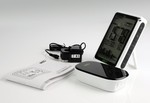- Displays real-time Cost/GHG emission/Power consumption
- Display time, calendar, temperature and humidity
- View the data of past 7 hours/7 days/7 weeks and 24 months
- Historical graphical chart of electricity consumption
- Average daily consumption alarm
- Single, two or three phases system compatible·
- Data can be transferred to PC using USB cable. View energy consumption on your PC
Mieo Wireless Home Energy / Power Monitoring Device, Data Transfer to PC - $79 + FREE Delivery
Related Stores
closed Comments

Pretty sure you can get those answers by clicking on the link.

usually for the electrical measurement devices the accuracy is defined by accuracy class and not % as mentioned in the specs..anyways i am not concerned about the accuracy .. i hope this meter has the Oz C-tick approval else i am not sure if its safe to use it.. here is some information about the rule.. http://www.acma.gov.au/WEB/STANDARD..PC/pc=PC_2796

C tick is not relevant to "safety" as such
You would find that your mobile phone is "much less safe" given the close proximity RF radiation and localised heating it gives your face when using it…………..

"Accuracy: 95+%"
So if it says you are using 2kW, it could be out by 100W.
And there are often daft rules in Australia about users not being able to install clamp meters themselves.

It's odd that it only mentions a clamp sensor, to measure power you need voltage and current sensing

True, but if you are clamping onto "standard house mains" cables you already know that they are at about 230-240V potential.
The measuring device is "close enough" for practical applications.
You can estimate the voltage but not the angle (power factor) between the voltage and current. Different loads have varying power factors for example a vacuum cleaner may be 0.7 and a toaster 1.0 meaning that there would be a 30% difference in consumed power if these devices were drawing the same current.

@Keeno - power factor impacts apparent power, not real power. Your power meter and the amount you're charged by your power company is totally unaffected by apparent power.
Read more here: http://www.dansdata.com/gz028.htm
Those little devices that tell you they can save you electricity/money on running appliances (as opposed to the auto-off-when-idle devices) change the apparent power/power factor, so your little power meter/multimeter that you measure at each individual advice LOOKS like it's saving you money. But your actual usage will remain the same (if anything it'll go up marginally as it adds a minor amount of resistance).

Hi tantryl - I'm not sure what you mean by impacts.
Apparent power (VA) is the sum of the power (kW) and reactive power (VAr) vectors. Apparent power in a single phase system is simply amps multiplied by volts as it does not take into account the phase angle. Power authorities charge for kW hours not VA hours. To measure this a meter needs a voltage input like the meter that the power authority uses to charge you.
This means that at best, this meter can only provide a rough guide on how much power is being consumed it may be 95% accurate for current measurement, but certainly not for power consumption.

What I'm saying is that if the advertised 95+% accuracy is correct then the power factor of individual devices will not impact it's accuracy.
Try the link. It explains it better than I could.

This looks very interesting, are there many gadgets out there like this?
Does anyone have somthing similar to comment on practicality of use?

A few similar things have been posted over the last year.
I put this one up for $39.15: http://www.ozbargain.com.au/node/45351
This one was $99: http://www.ozbargain.com.au/node/44103
Agree "is close enough", I have reviewed and trialled a bucket load of this type of HEMs(Home Energy Monitor) over the years.
Voltage can be upto 250V, which is common in the area I live in.
Clamp meter can be installed readily enough on many switchboards without having to have electrical quailifications.
Cost for similar products range from $50-$250 dollars, I think Brisbane Council were giving away this style of meter for a while!
Some meters come with web connectivity so you can use the google energy meter and open source software
Also for those with PV there is one HEM I have seen that can give energy "in" and energy "out".The advetised functionality of this unit makes it good for the price.

You seem pretty "switched on" about this stuff, which would you reccomend for ease of use and practicality?
Sorry OP for hijacking deal discussion.

Whats the point of this?

Hi - I tried to place an order but it tries to add postage. How do I get free postage? And it also tried to add GST on top of the $79 mentioned. Why is this?

"Can be used on three phase systems (requires the purchase of additional sensors)"
Where do we get these additional sensors and how much does it cost to get them?
I do a search for this product and it seems its one of those Chinese made items.. so my question is, whats the quality and reliability of it compared to other devices similar to this one??


hello rep can you please confirm the accuracy level of this meter and does it use CT's? whats the accuracy of the data..